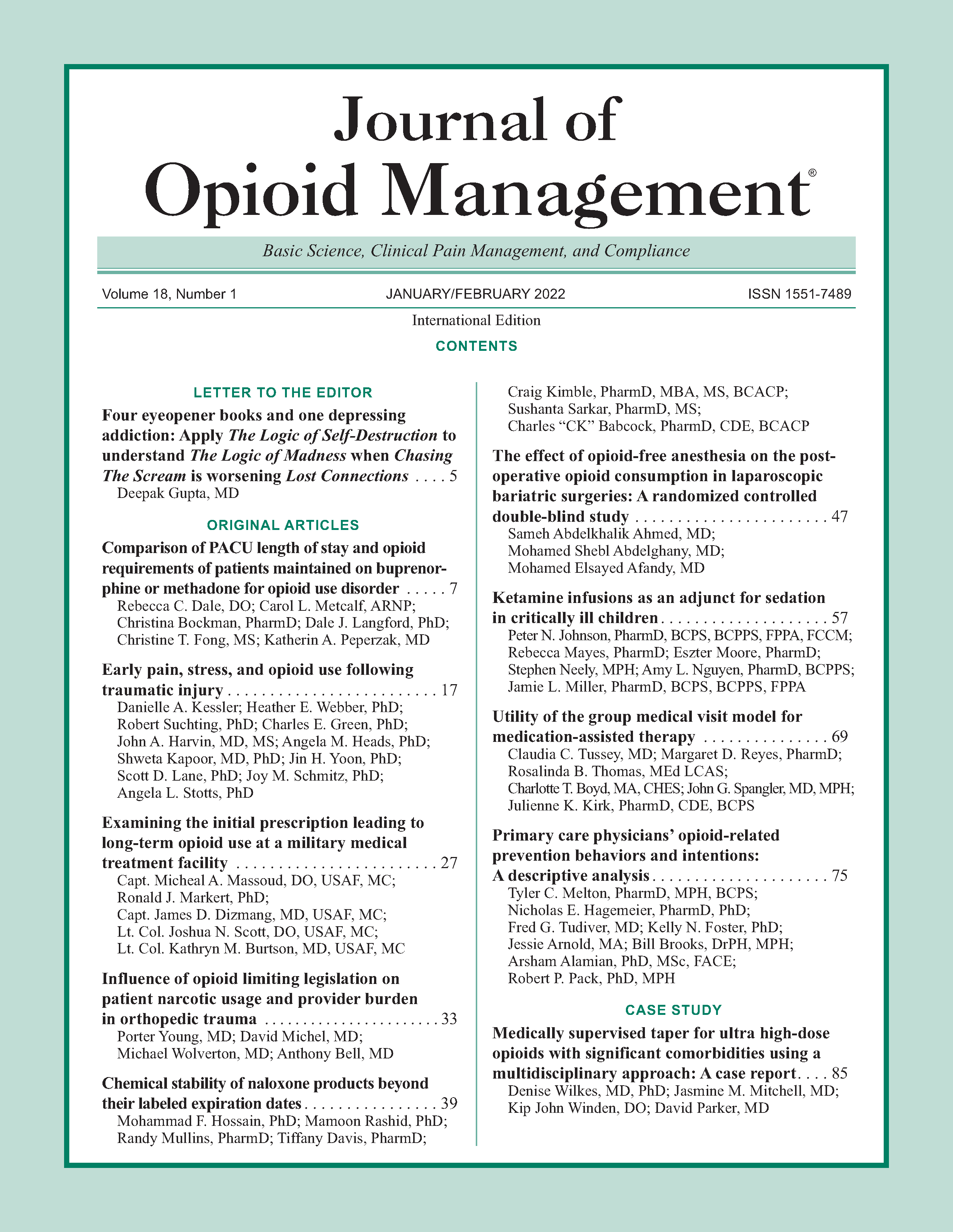Comparison of PACU length of stay and opioid requirements of patients maintained on buprenorphine or methadone for opioid use disorder
DOI:
https://doi.org/10.5055/jom.2022.0689Keywords:
buprenorphine, methadone, opioid use disorderAbstract
Objectives: Literature supporting best practice of perioperative buprenorphine management for opioid use disorder is evolving with more recent studies trending toward maintenance of home dose. To guide treatment protocols at our institution, we evaluated patients taking medication for opioid use disorder (MOUD) undergoing similar surgeries. Patients were maintained on either their outpatient buprenorphine or methadone.
Patients and participants: Data were collected on 46 patients maintained on buprenorphine MOUD who underwent surgery. A subset of these patients (n = 24) was compared with 24 patients maintained on methadone MOUD, matched on surgical procedure, admission date, age, and sex.
Design: This is a retrospective matched control study.
Setting: An academic, tertiary, Level 1 trauma center.
Main outcome measures: Primary outcomes were post-operative opioid use and post-anesthesia care unit (PACU) length of stay.
Results: No significant differences in demographic characteristics, physical status, comorbid psychiatric diagnoses, or illicit substance use history were observed between patient groups. A higher proportion of patients taking methadone was admitted due to infection (41.7 percent vs 16.7 percent, p = 0.031) and underwent nonelective surgery (75.0 percent vs 45.8 percent, p = 0.039). No significant differences were observed between patients taking buprenorphine versus methadone with respect to PACU length of stay, post-operative opioid consumption, time-to-transition to oral opioids, or discharge opioid prescriptions. Patients taking buprenorphine were more likely to receive intravenous lidocaine (25.0 percent vs 0.0 percent, p = 0.031) and ketamine (83.3 percent vs 54.2 percent, p = 0.039).
Conclusion: Findings from this study support accumulating evidence that patients should be maintained on buprenorphine MOUD throughout the perioperative period.
References
Noormohammadi A, Forinash A, Yancy A, et al.: Buprenorphine versus methadone for opioid dependence in pregnancy. Ann Pharmacother. 2016; 50(8): 666-672.
Oesterle TS, Thusius NJ, Rummans TA, et al.: Medication-assisted treatment for opioid-use disorder. Mayo Clin Proc. 2019; 94(10): 2072-2086.
Kress HG: Clinical update on the pharmacology, efficacy and safety of transdermal buprenorphine. Eur J Pain 2009; 13(3): 219-230.
Khanna IK, Pillarisetti S: Buprenorphine—An attractive opioid with underutilized potential in treatment of chronic pain. J Pain Res. 2015; 8: 859-870. DOI: 10.2147/JPR.S85951.
Cote J, Montgomery L: Sublingual buprenorphine as an analgesic in chronic pain: A systematic review. Pain Med. 2014; 15: 1171-1178. DOI: 10.1111/pme.12386.
Harrington CJ, Zaydfudim V: Buprenorphine maintenance therapy hinders acute pain management in trauma. Am Surg. 2010; 76(4): 397-399.
Coe MA, Lofwall MR, et al.: Buprenorphine pharmacology review: Update on transmucosal and long-acting formulations. J Addict Med. 2019; 13(2): 93-103.
Huang A, Katznelson R, de Perrot M, et al.: Perioperative management of a patient undergoing Clagett window closure stabilized on suboxone(R) for chronic pain: A case report. Can J Anesth/J Can Anesth. 2014; 61(9): 826-831.
Chern SY, Isserman R, Chen L, et al.: Perioperative pain management for patients on chronic buprenorphine: A case report. J Anesth Clin Res. 2013; 3(250): 1000250.
Israel JS, Poore SO: The clinical conundrum of perioperative pain management in patients with opioid dependence: Lessons from two cases. Plast Reconstr Surg. 2013; 131(4): 657e-658e.
Kornfeld H, Manfredi L: Effectiveness of full agonist opioids in patients stabilized on buprenorphine undergoing major surgery: A case series. Am J Ther. 2010; 17(5): 523-528.
Macintyre PE, Russell RA, Usher KA, et al.: Pain relief and opioid requirements in the first 24 hours after surgery in patients taking buprenorphine and methadone opioid substitution therapy. Anaesth Intensive Care. 2013; 41(2): 222-230.
Vilkins AL, Bagley SM, Hahn KA, et al.: Comparison of post-cesarean section opioid analgesic requirements in women with opioid use disorder treated with methadone or buprenorphine. J Addict Med. 2017; 11(5): 397-401.
Mitra S, Sinatra RS: Perioperative management of acute pain in the opioid-dependent patient. Anesthesiology. 2004; 101(1): 212-227.
Alford A, Compton P, Samset J: Acute pain management for patients receiving maintenance methadone or buprenorphine therapy. Ann Intern Med. 2006; 144: 127-134.
Jonan AB, Kaye AD, Urman RD: Buprenorphine formulations: Clinical best practice strategies recommendations for perioperative management of patients undergoing surgical or interventional pain procedures. Pain Phys. 2018; 1(1): E1-E12.
Greenwald MK, Comer SD, Fiellin DA: Buprenorphine maintenance and mu-opioid receptor availability in the treatment of opioid use disorder: Implications for clinical use and policy. Drug lcohol Depend. 2014; 144: 1-11.
Quaye A, Potter K, Roth S, et al.: Perioperative continuation of buprenorphine at low-moderate doses was associated with lower postoperative pain scores and decreased outpatient opioid dispensing compared with buprenorphine discontinuation. Pain Med. 2020; 21(9): 1955-1960.
The American Society of Addiction Medicine: The American Society of Addiction Medicine’s National Practice Guideline for the Treatment of Opioid Use Disorder 2020 Focused Update. ASAM. 2020. Available at https://www.asam.org/docs/default-source/quality-science/npg-jam-supplement.pdf?sfvrsn=a00a52c2_2. Accessed November 3, 2021.
Sacerdote P: Opioids and the immune system. Palliat Med. 2006; 20(Suppl. 1): S9-S15. PMID: 16764216.
Soltani G, Khorsand M, Shamloo AS, et al.: Comparison of intravenous morphine with sublingual buprenorphine in management of post-operative pain after close reduction orthopedic surgery. Arch Bone Jt Surg. 2015; 3(4): 280-285.
Raffa RB, Haidery R, Huang HM, et al.: The clinical analgesic efficacy of buprenorphine. J Clin Pharm Ther. 2014; 39(6): 577-583.
Carl P, Crawford M, Madsen N, et al.: Pain relief after major abdominal surgery: A double blinded controlled comparison of sublingual buprenorphine, intramuscular buprenorphine, and intramuscular meperidine. J Anesth Analg. 1986; 66: 142-146.
Derbyshire DR, Vater M, Maile CID, et al.: Non-parenteral postoperative analgesia: A comparison of sublingual buprenorphine and morphine sulphate (slow release) tablets. Anesthesia. 1984; 39: 324-328.
Houchard G, Kullgren J, Saphire M, et al.: Hospital opioid requirements following continuation versus discontinuation of buprenorphine for addiction—A retrospective cohort study. J Pain Palliat Care Pharmacother. 2019; 33(3-4): 98-106.
Carroll IR, Angst MS, Clark JD: Management of perioperative pain in patients chronically consuming opioids. Reg Anesth Pain Med. 2004; 29(6): 576-591.
Huxtable CA, Roberts LJ, Somogyi AA, et al.: Acute pain management in opioid-tolerant patients: A growing challenge. Anaesth Intensive Care. 2011; 39(5): 804-823.
Published
How to Cite
Issue
Section
License
Copyright 2005-2024, Weston Medical Publishing, LLC
All Rights Reserved














